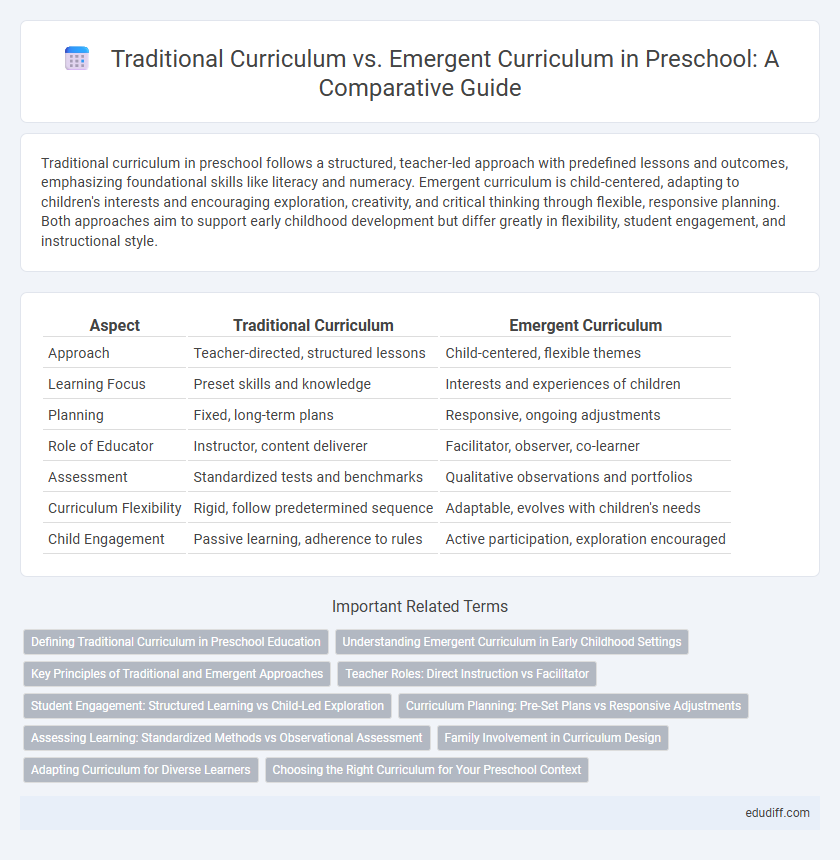Traditional curriculum in preschool follows a structured, teacher-led approach with predefined lessons and outcomes, emphasizing foundational skills like literacy and numeracy. Emergent curriculum is child-centered, adapting to children's interests and encouraging exploration, creativity, and critical thinking through flexible, responsive planning. Both approaches aim to support early childhood development but differ greatly in flexibility, student engagement, and instructional style.
Table of Comparison
| Aspect | Traditional Curriculum | Emergent Curriculum |
|---|---|---|
| Approach | Teacher-directed, structured lessons | Child-centered, flexible themes |
| Learning Focus | Preset skills and knowledge | Interests and experiences of children |
| Planning | Fixed, long-term plans | Responsive, ongoing adjustments |
| Role of Educator | Instructor, content deliverer | Facilitator, observer, co-learner |
| Assessment | Standardized tests and benchmarks | Qualitative observations and portfolios |
| Curriculum Flexibility | Rigid, follow predetermined sequence | Adaptable, evolves with children's needs |
| Child Engagement | Passive learning, adherence to rules | Active participation, exploration encouraged |
Defining Traditional Curriculum in Preschool Education
Traditional curriculum in preschool education is a structured approach that emphasizes teacher-directed instruction and predetermined learning objectives focused on foundational skills such as literacy, numeracy, and social behavior. This curriculum follows a fixed schedule and standardized content designed to prepare children for elementary education through sequenced lessons and consistent assessment methods. It contrasts with emergent curriculum by prioritizing uniformity, routine, and measurable outcomes over child-led exploration and adaptive learning experiences.
Understanding Emergent Curriculum in Early Childhood Settings
Emergent curriculum in early childhood settings centers on children's interests and experiences, promoting active exploration and meaningful learning through responsive planning. Unlike traditional curriculum's predetermined goals, emergent approaches adapt daily activities based on observations and interactions, fostering creativity and critical thinking. This child-led framework supports holistic development by integrating themes relevant to each child's unique environment and cultural background.
Key Principles of Traditional and Emergent Approaches
The traditional curriculum in preschool emphasizes structured, teacher-led activities with predefined objectives centered on academic skills and standardized assessments. In contrast, the emergent curriculum values child-centered learning, prioritizing students' interests, experiences, and active exploration to foster creativity and critical thinking. Both approaches consider developmental milestones, but the emergent curriculum adapts dynamically to children's evolving needs and contextual environments.
Teacher Roles: Direct Instruction vs Facilitator
In a traditional preschool curriculum, teachers primarily assume the role of direct instructors, delivering structured lessons and guiding children through predetermined learning objectives. In contrast, an emergent curriculum positions teachers as facilitators who observe children's interests and adapt activities to support exploration and discovery-driven learning. This shift from direct instruction to facilitation encourages greater engagement and fosters critical thinking skills in early childhood education.
Student Engagement: Structured Learning vs Child-Led Exploration
Traditional curriculum emphasizes structured learning with predetermined activities that promote focused skill development and consistent routines. Emergent curriculum fosters student engagement through child-led exploration, encouraging creativity, critical thinking, and responsive adaptation based on children's interests. Balancing these approaches can optimize preschool engagement by integrating intentional guidance with opportunities for spontaneous discovery.
Curriculum Planning: Pre-Set Plans vs Responsive Adjustments
Traditional preschool curricula rely on pre-set plans with fixed learning objectives and structured daily schedules designed by educators, ensuring consistency and clear benchmarks for development. Emergent curricula prioritize responsive adjustments, allowing teachers to adapt activities based on children's interests, needs, and spontaneous discoveries, fostering engagement and personalized learning. Effective curriculum planning in early childhood education balances these approaches to support both foundational skill-building and dynamic, child-centered exploration.
Assessing Learning: Standardized Methods vs Observational Assessment
Standardized assessment methods in preschool traditional curriculum emphasize uniform testing to measure predefined skills, providing quantifiable data for developmental benchmarks. Observational assessment in emergent curriculum allows educators to document children's learning processes and social interactions in natural settings, offering a holistic understanding of individual growth. This approach supports personalized interventions by capturing real-time engagement and skill application beyond standardized metrics.
Family Involvement in Curriculum Design
Family involvement in curriculum design significantly differs between traditional and emergent preschool curricula. Traditional curricula often rely on predetermined content with limited family input, focusing primarily on teacher-led instruction and standardized goals. In contrast, emergent curricula prioritize active family engagement by incorporating children's interests and cultural backgrounds, fostering a collaborative approach to learning that reflects the unique needs and experiences of each family.
Adapting Curriculum for Diverse Learners
Traditional curriculum in preschools follows a fixed, teacher-directed plan that emphasizes structured lessons and uniform learning objectives, often limiting flexibility for diverse learners. Emergent curriculum adapts to children's interests, cultural backgrounds, and developmental needs, promoting inclusivity and personalized learning experiences. Tailoring activities and materials to individual strengths and challenges enhances engagement and supports cognitive, social, and emotional growth in diverse preschool classrooms.
Choosing the Right Curriculum for Your Preschool Context
Selecting the right curriculum for your preschool depends on your educational philosophy, student needs, and community context. Traditional curriculum offers structured, teacher-led learning with predetermined goals, while emergent curriculum fosters child-centered exploration based on students' interests and experiences. Evaluating factors like developmental appropriateness, flexibility, and family involvement ensures the curriculum aligns with your preschool's mission and supports holistic child development.
Traditional Curriculum vs Emergent Curriculum Infographic

 edudiff.com
edudiff.com